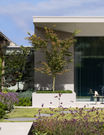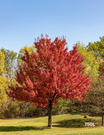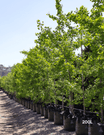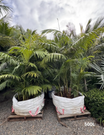A woodland garden offers a serene escape into nature, replicating the charm and tranquility of forests. These naturalized spaces create a sanctuary that fosters biodiversity while maintaining a sense of effortless luxury. Using trees to craft this kind of garden can add depth, shade, and structure, evoking the peaceful ambiance of woodland groves. Whether designing a sprawling estate or a more intimate setting, selecting the right trees is essential for achieving a vibrant, thriving landscape. In this guide, we'll explore some of the best trees for naturalizing in a woodland-style garden, focusing on Acer negundo (Box Elder) and two other species known for their beauty and resilience.
Acer negundo (Box Elder)
Acer negundo 'Sensation' is a standout cultivar of the Box Elder maples, particularly cherished for its dazzling autumnal color display. This medium-sized deciduous tree proudly showcases deep burgundy-red hues during the fall, offering a captivating contrast to the lush green landscapes. Growing to a typical height of 10 to 12 meters, 'Sensation' is not just resilient but also presents an alluring, rounded canopy, making it an ideal specimen for gardens, parks, and streetscapes.
Key Facts:
- Mature Height: 10-12 meters
- Mature Width: 8-10 meters
- Best Uses: Naturalizing in woodland gardens, informal hedging, or riparian zones
- Leaf Appearance: Pinnately compound leaves with bright green foliage, turning yellow in autumn
- Rate of Growth: Fast-growing
- Tolerates: Drought, poor soils, wet conditions, and urban environments
Why Acer negundo is Perfect for Your Garden:
Acer negundo offers a balance of ease and beauty. Its fast growth rate means that in a short period, your garden can have an established canopy, providing shade and a habitat for local wildlife. If you want to create a woodland garden that feels effortless yet lush, this tree's adaptability to different soil types and moisture conditions makes it a valuable addition. It tolerates drought and wet conditions, so it’s versatile for areas with variable weather patterns. The vibrant green foliage of Box Elder adds a striking contrast to the more muted tones of the woodland floor, creating visual interest throughout the year, particularly in autumn when the leaves turn a golden yellow.
Betula pendula (Silver Birch)
Few trees evoke the woodland aesthetic more strongly than the Betula pendula, or Silver Birch. With its slender, white trunks and graceful, airy foliage, the Silver Birch adds texture and lightness to a garden while retaining that woodland charm. Known for its adaptability to various conditions, Betula pendula thrives in various soil types, making it a versatile choice for naturalizing.
Key Facts:
- Mature Height: 10-25 meters
- Mature Width: 5-10 meters
- Best Uses: Woodland gardens, naturalistic planting schemes, riverbanks, and informal groupings
- Leaf Appearance: Small, serrated, diamond-shaped leaves that turn yellow in autumn
- Rate of Growth: Medium to fast-growing
- Tolerates: Cold climates, damp soils, and light shade
Why Betula pendula is Perfect for Your Garden:
Betula pendula brings a sense of light and movement to a woodland garden. Its pale bark stands out against the darker foliage of other trees, particularly in winter, making it a year-round feature. In autumn, its leaves turn a warm golden yellow, adding seasonal interest. This tree works well in group plantings or as a single specimen, lending an airy feel to areas that might otherwise seem dense. Its ability to thrive in poor soils and its tolerance for wet regions make it an excellent option for a garden that mimics the natural ebb and flow of woodland ecosystems.
Fraxinus excelsior (European Ash)
The Fraxinus excelsior, or European Ash, is a magnificent tree that embodies the essence of a woodland garden. Its broad, open canopy and attractive, pinnate leaves create an inviting and expansive feel to any space. Known for its rapid growth and hardy nature, Fraxinus excelsior is a reliable choice for naturalizing, especially in larger gardens.
Key Facts:
- Mature Height: 20-30 meters
- Mature Width: 12-20 meters
- Best Uses: Large woodland gardens, parkland settings, and open spaces requiring shade
- Leaf Appearance: Dark green, pinnate leaves that turn golden yellow in autumn
- Rate of Growth: Fast-growing
- Tolerates: Damp soils, full sun, and partial shade
Why Fraxinus excelsior is Perfect for Your Garden:
Fraxinus excelsior offers the perfect balance of scale and beauty for those looking to create a grander woodland effect. Its towering height and wide spread make it ideal for large estates where a dramatic canopy is desired. Its deep roots and tolerance for various soil types, including wet conditions, make it an excellent candidate for naturalizing in low-lying areas. In autumn, its golden foliage lights up the landscape, providing a vibrant contrast against the deep greens of evergreen species. Despite its grand stature, Fraxinus excelsior requires minimal maintenance once established, making it perfect for clients who seek low-effort, high-impact results.
Planting Tips for a Thriving Woodland Garden
When planning your woodland garden, it's essential to consider the types of trees you select and their placement and care. Here are a few tips to help your trees thrive:
- Layer your trees: For height and structure, start with tall canopy trees like Fraxinus excelsior, followed by mid-story trees like Betula pendula, and underplant with smaller shrubs and groundcovers for depth and variety.
- Select trees suited to your soil: Ensure your tree selections can thrive in your garden's specific conditions. Acer negundo, for example, is incredibly tolerant of wet and dry soils, while Betula pendula prefers slightly damp conditions.
- Focus on biodiversity: Planting a mix of deciduous and evergreen species will ensure year-round interest, support local wildlife, and create a more dynamic ecosystem.
- Use mulch: Apply a thick layer of organic mulch around the base of each tree to help retain moisture, regulate soil temperature, and suppress weeds.
- Watering: Newly planted trees need consistent watering for the first two years, especially during dry periods. Mature trees will be more resilient, but watering deeply during prolonged droughts is essential.
FAQs
How much space do I need for a woodland garden?
Woodland gardens can be adapted to fit a range of garden sizes. If you're working with a smaller space, consider planting compact species like Betula pendula and creating an understory of shade-tolerant plants.
Can I plant evergreen trees in my woodland garden?
Yes, evergreens can provide structure and year-round interest in a woodland garden. Consider species like Fraxinus excelsior or other native Australian evergreens to complement deciduous trees.
What is the best time to plant trees for a woodland garden?
The best time to plant is in early autumn or spring, when the weather is cooler. This allows roots to establish before the heat of summer or the cold of winter.
By carefully selecting the right trees for your woodland garden, you can create a naturalized space that thrives year after year. Whether you’re drawn to the fast-growing beauty of Acer negundo, the airy elegance of Betula pendula, or the commanding presence of Fraxinus excelsior, each tree brings unique qualities that will enhance your garden’s natural charm.









































Leave a comment
This site is protected by hCaptcha and the hCaptcha Privacy Policy and Terms of Service apply.